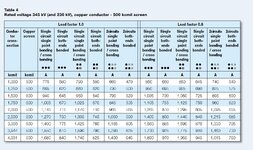Skin effect comes to mind.
Some of the things affecting ampacity;
The temperature limit of the insulation and or surroundings.
The ability to radiate the heat losses so as to limit the temperature rise.
Consider;
The three conductor cable has less effective surface area per conductor to radiate heat.
At 400 kV, the insulation will be quite thick and form a thermal insulation as well as an electrical insulation.
There will be a temperature drop through the insulation and the internal temperature will be considerably higher than the surface temperature.
The 2000 sq mm cable will be equivalent to almost two inches diameter of solid conductor. Stranding will increase this diameter.
The skin effect will be considerable.
Parallel cables or hollow conductors are often used at this current level. (IPS Bus, That is, aluminum tubing constructed to Iron Pipe Sizes is often used as a conductor at high current levels due to skin effect.)
From 2000 sq.mm.to 2500 sq. mm. you are increasing the cross sectional area by 25% but you are increasing the surface area to radiate heat by only 12%.
Just for fun, try running your calculations with a 1 inch hollow core and with 1 1/2 inch and 2 inch hollow cores.
The results may lead you to investigate the feasibility of having cables constructed around a core of rope or some other substance.
Bottom line, a 10 Amp increase does seem low.
In addition to the other factors, I suspect that the thermal insulation may be the biggest issue.
Again, just for fun, try running the calculations with several steps of thinner insulation and see if the results suggest a reason.

